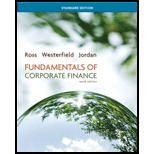
To find: The book value for a share, the market value for a share, and the earnings per share. The
Introduction:
Dilution is the loss in the current shareholders value with respect to the percentage ownership, market value of the shares they hold, or, reduction in the book value or earnings per share.
Answer to Problem 10QP
The book value for a share is $102.92, the market value for a share is $0.6907, the earnings per share is $19.88, and the net present value is - $248,083.91.
Explanation of Solution
Given information:
Company M wishes to diversify their operation. The company is looking at an investment that has the similar price earnings ratio as the company. The investment cost is $800,000 and it is funded with the new equity issue. The return on investment is equal to the
- The stock price is $76.
- The number of shares is 40,000.
- The total liabilities is $3,100,000.
- The total assets is $7,500,000.
- The net income is $850,000.
Explanation:
Formula to calculate the owner’s equity:
Note: The owner’s equity is calculated in order to determine the return on equity (ROE).
Computation of the owner’s equity:
Hence, the owner’s equity is $4,400,000.
Formula to calculate the return on equity:
Computation of the return on equity (ROE):
Hence, the ROE is 0.1932 or 19.32%.
Computation of the new net income:
Since the return on investment will be the same as the current ROE, compute the new net income using the above formula of the ROE:
The owners’ equity will comprise the new investment for the calculation of the ROE.
Hence, the new net income $1,004,545.455.
Formula to compute the current earnings per share:
Computation of the earnings per share:
Hence, the earnings per share is $21.25 for a share.
Formula to calculate the number of the new shares to be issued:
Note: The required investment is $800,000.
Computation of the number of the new shares to be issued:
Hence, the new shares to be issued is 10,526.32 shares.
Computation of the earnings per share after the stock issue:
Hence, the earnings per share after the stock issue is $19.88.
Formula to calculate the P/E (price earnings) ratio:
Computation of the P/E (price earnings) ratio:
Hence, the price earnings ratio is 3.576.
Formula to calculate the new stock price for a share:
Computation of the new stock price for a share:
The price earnings ratio remains the same and the new stock price of the company after the stock offer is calculated as follows:
Hence, the new price of the stock is $71.09.
Formula to calculate the current book value for a share:
Computation of the current book value for a share:
Hence, the current book value of a share is $110.
Formula to calculate the new book value for a share:
Computation of the new book value for a share:
Hence, the new book value of a share is $102.92.
Formula to calculate the market to book value before the stock offer:
Computation of the market to book value after the stock offer:
Hence, the market-to-book value after the stock offer is $0.6907.
Computation of the net present value of the new investment:
The net present value is determined by adding the cost of the new investment with the difference between the new market value of the company and the current market value of the company.
Hence, the net present value is - $248,083.91.
Explanation:
In this case of Company M, the dilution had taken place after the investment made in the diversification projects due to the following reasons:
-
- The market-to-book ratio is less than one.
- The NPV of the new project investment for Company M is negative.
Want to see more full solutions like this?
Chapter 15 Solutions
Fundamentals of Corporate Finance Standard Edition with Connect Plus
 Essentials Of InvestmentsFinanceISBN:9781260013924Author:Bodie, Zvi, Kane, Alex, MARCUS, Alan J.Publisher:Mcgraw-hill Education,
Essentials Of InvestmentsFinanceISBN:9781260013924Author:Bodie, Zvi, Kane, Alex, MARCUS, Alan J.Publisher:Mcgraw-hill Education,

 Foundations Of FinanceFinanceISBN:9780134897264Author:KEOWN, Arthur J., Martin, John D., PETTY, J. WilliamPublisher:Pearson,
Foundations Of FinanceFinanceISBN:9780134897264Author:KEOWN, Arthur J., Martin, John D., PETTY, J. WilliamPublisher:Pearson, Fundamentals of Financial Management (MindTap Cou...FinanceISBN:9781337395250Author:Eugene F. Brigham, Joel F. HoustonPublisher:Cengage Learning
Fundamentals of Financial Management (MindTap Cou...FinanceISBN:9781337395250Author:Eugene F. Brigham, Joel F. HoustonPublisher:Cengage Learning Corporate Finance (The Mcgraw-hill/Irwin Series i...FinanceISBN:9780077861759Author:Stephen A. Ross Franco Modigliani Professor of Financial Economics Professor, Randolph W Westerfield Robert R. Dockson Deans Chair in Bus. Admin., Jeffrey Jaffe, Bradford D Jordan ProfessorPublisher:McGraw-Hill Education
Corporate Finance (The Mcgraw-hill/Irwin Series i...FinanceISBN:9780077861759Author:Stephen A. Ross Franco Modigliani Professor of Financial Economics Professor, Randolph W Westerfield Robert R. Dockson Deans Chair in Bus. Admin., Jeffrey Jaffe, Bradford D Jordan ProfessorPublisher:McGraw-Hill Education





